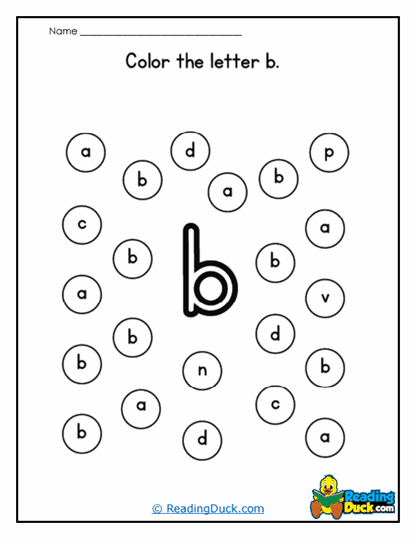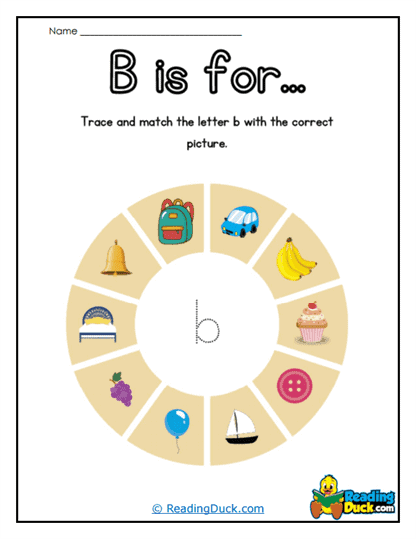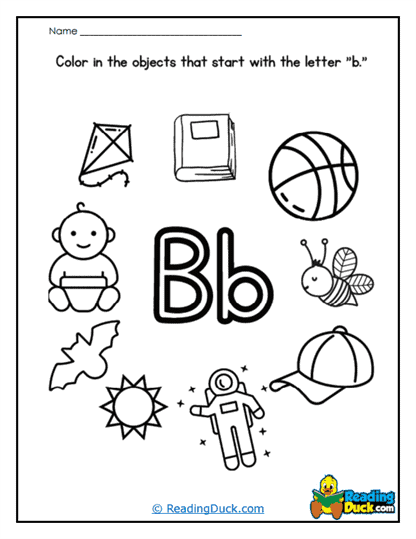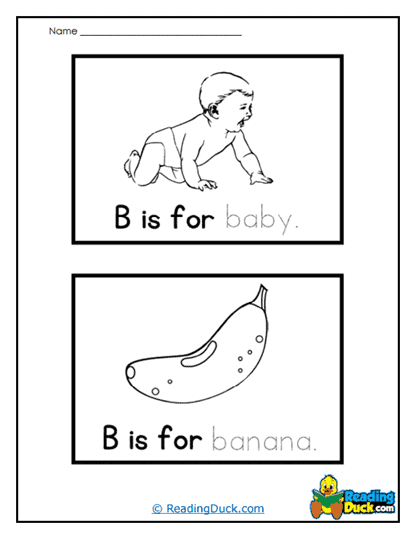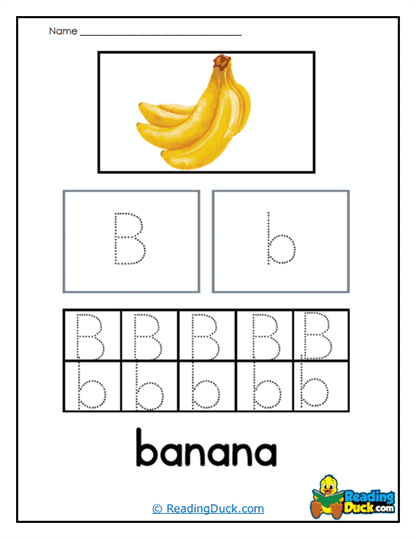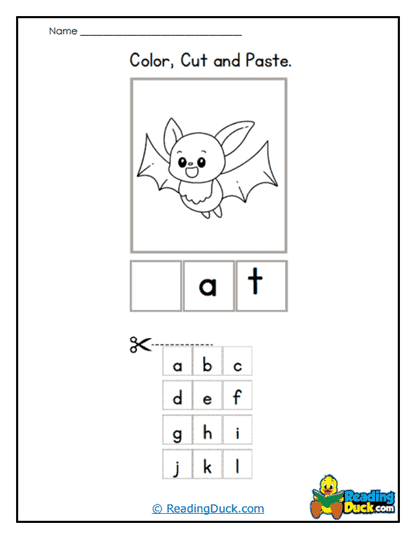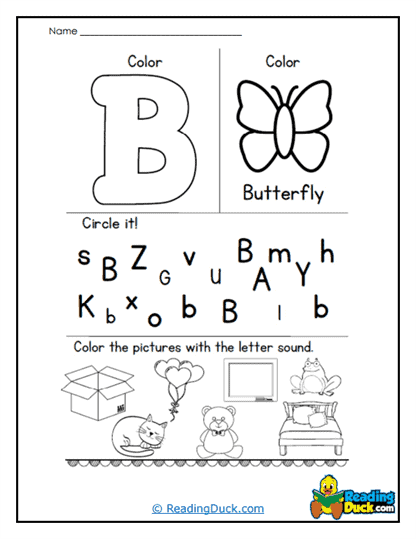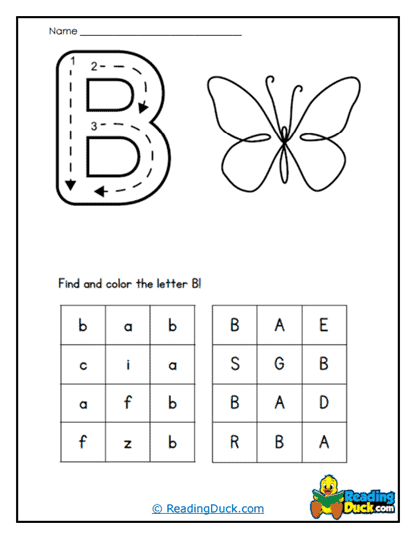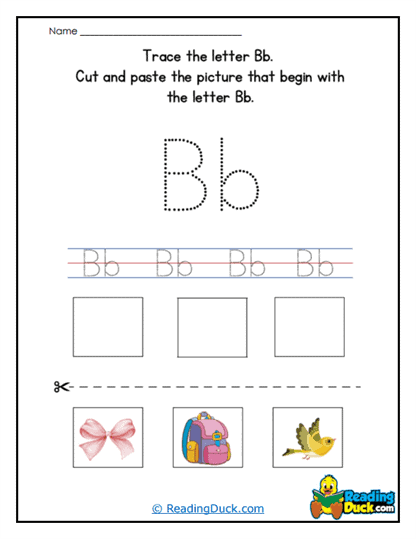Letter B Worksheets
About Our Letter B Worksheets
All worksheets in this collection contain Letter B worksheets that are visually engaging to young students. This collection includes various activities designed to improve young learners’ familiarity with the letter B in terms of reading, recognizing, and writing it. These worksheets are all readily available in PDF files, making them easy to view electronically, download, and print out for usage. An answer key is provided for every worksheet.
Exploring the World of the Letter B
The letter B is the second letter of the alphabet and holds significant importance in early literacy education. Understanding the letter B is essential for young learners as they begin to build their foundational skills in reading and writing. Teaching the letter B provides students with an opportunity to explore its various forms, sounds, and applications, which are crucial for their language development.
Key aspects of the letter B to present to students:
- Alphabetical Order and Recognition: The letter B follows A, making it one of the first letters children learn as they explore the alphabet. Recognizing the letter B in both uppercase and lowercase forms helps students develop their alphabetic knowledge, a fundamental component of literacy.
- Phonetic Understanding: The letter B typically represents a consonant sound, as heard in words like "ball," "bat," and "butterfly." Introducing students to the sound of the letter B helps them connect the letter to its corresponding sound, which is vital for decoding words and developing phonemic awareness.
- Visual and Auditory Association: Associating the letter B with familiar words and images strengthens students' ability to recognize the letter in various contexts. For example, when students see the word "ball" paired with an image of a ball, they can more easily remember and identify the letter B.
- Writing Practice: Writing the letter B involves understanding the correct formation and strokes needed to create the letter. Through guided practice, students can master the writing of both uppercase and lowercase B, which is important for their handwriting development.
- Word Building and Vocabulary Expansion: As students learn the letter B, they can begin to form simple words that start with B. This activity not only builds their vocabulary but also enhances their ability to construct and understand words, which is a critical skill in reading and writing.
- Engagement Through Creativity: Teaching the letter B offers numerous opportunities for creative activities. Whether it's crafting, drawing, or storytelling, incorporating creative elements into lessons can make learning the letter B more enjoyable and memorable for students.
By focusing on these aspects, teachers can help students develop a strong understanding of the letter B, setting the stage for future literacy success.
Integrating Letter B Worksheets into Your Curriculum
Creative Ways to Use Letter B Worksheets in the Classroom
Integrating Letter B worksheets into your curriculum can be both fun and educational. Here are some practical ideas for incorporating these worksheets into daily lessons, ensuring that students engage with the material in meaningful ways:
- Daily Alphabet Practice: Begin each day with a short activity focused on the letter B. This could involve students identifying the letter in various words, tracing it, or saying words that begin with B. Follow up with a worksheet to reinforce what they have learned.
- Letter of the Week Focus: Designate one week to concentrate on the letter B. Each day, explore different aspects of the letter, such as its sound, how it is written, and words that start with B. Use the worksheets as part of your daily lessons to reinforce learning.
- Storytime Integration: Select stories that prominently feature the letter B. As you read the story to the class, encourage students to listen for words that begin with B. Afterward, have students complete a worksheet that reinforces their understanding of the letter.
- Interactive Learning Centers: Set up stations in your classroom where students can rotate through different activities centered on the letter B. Include hands-on activities, such as sorting objects that start with B, alongside worksheets that help reinforce recognition and writing skills.
- Art and Craft Projects: Incorporate art into your lessons by having students create crafts related to the letter B. For example, students could make a "B is for Butterfly" collage or build a simple "B is for Boat" out of paper. These activities can be complemented with worksheets to reinforce the letter’s shape and sound.
- Group Projects: Encourage students to collaborate on a group project, such as creating a "Letter B Book" where each student contributes a page featuring a word that starts with B. Use the worksheets as a guide for students as they create their pages.
- Homework Assignments: Assign Letter B worksheets as homework to provide additional practice outside of school. This allows parents to get involved in their child’s learning and helps reinforce the concepts covered in class.
- Cross-Curricular Connections: Link the letter B to other subjects. For example, in science, you could discuss animals that begin with B, such as bears or bees. In math, you might count objects that start with the letter B.
- Scavenger Hunts: Organize a scavenger hunt where students look for objects around the classroom or at home that begin with the letter B. After the hunt, they can complete a worksheet to practice writing and recognizing the letter.
- Assessment and Review: Use the worksheets as a tool for assessing students' understanding of the letter B. Review their completed worksheets to identify areas where they may need additional support or practice.
Grade Levels That Benefit Most
The Letter B worksheets are most beneficial for Pre-Kindergarten and Kindergarten students, as these are the critical years for learning letter recognition and early writing skills. These worksheets are also suitable for early First Grade students who may need extra practice with the letter B. Additionally, English Language Learners (ELL) at various ages can benefit from these worksheets as they work on familiarizing themselves with the English alphabet.
Enhancing Student Development Through Letter B Activities
Skills Development Through Letter B Worksheets
Working with Letter B worksheets offers students more than just letter recognition. These activities help develop a wide range of skills essential for both academic success and personal growth:
- Fine Motor Skills: Tracing and writing the letter B helps students develop the fine motor control necessary for handwriting and other tasks requiring precision.
- Cognitive Development: Engaging with the letter B in various forms—through recognition, writing, and word association—supports cognitive development by enhancing memory, pattern recognition, and problem-solving skills.
- Phonemic Awareness: Learning the sounds associated with the letter B is a vital step in developing phonemic awareness, which is the ability to hear, identify, and manipulate sounds in words.
- Language and Literacy Skills: Mastering the letter B contributes to the development of reading, spelling, and vocabulary skills, all of which are essential for future academic achievement.
- Creative Expression: Incorporating the letter B into art and storytelling activities encourages students to express themselves creatively, fostering a love for learning and exploration.
- Confidence and Independence: As students become more comfortable with the letter B, they gain confidence in their abilities, which can inspire a positive attitude toward learning and encourage independent study.
The Impact of Learning the Letter B
Building a Strong Foundation for Literacy
Learning the letter B is a significant milestone in early literacy education. By engaging with these Letter B worksheets, students not only learn to recognize and write this important letter, but they also develop a variety of essential skills that will support their academic journey. Whether used in the classroom or at home, these worksheets are a valuable resource for educators and parents alike, helping to foster a love of learning and laying the groundwork for successful reading and writing experiences.
